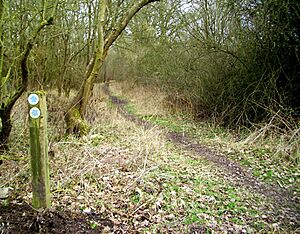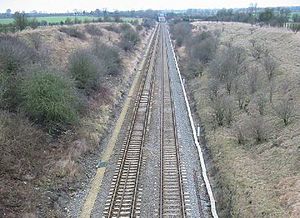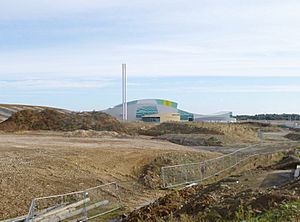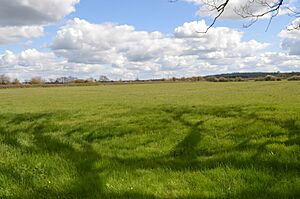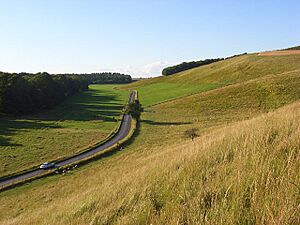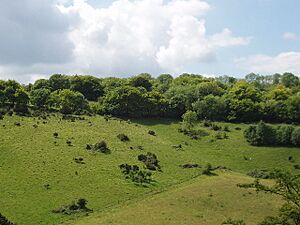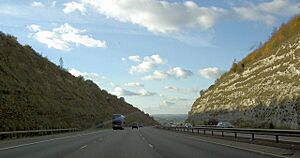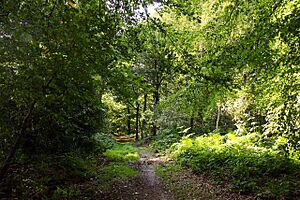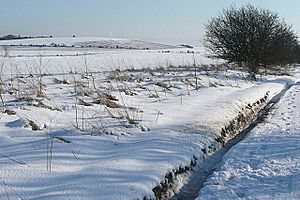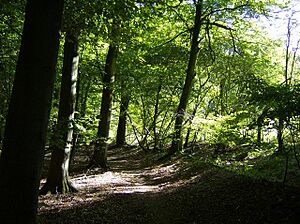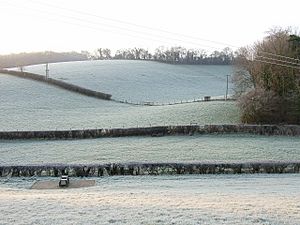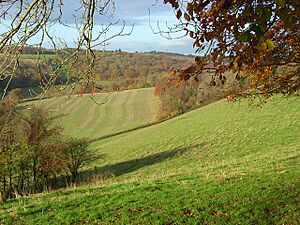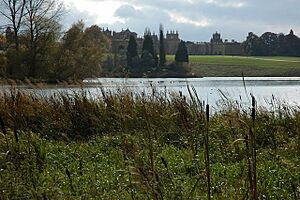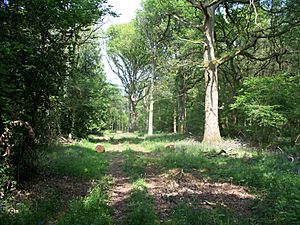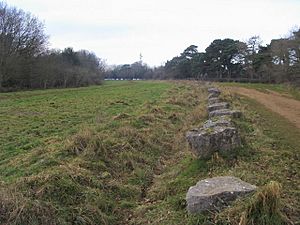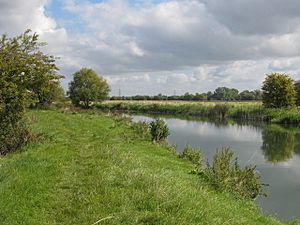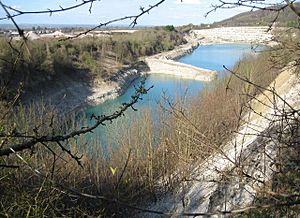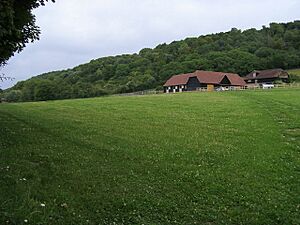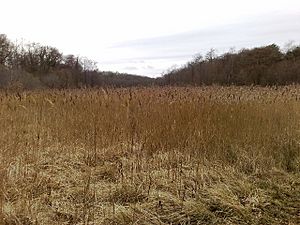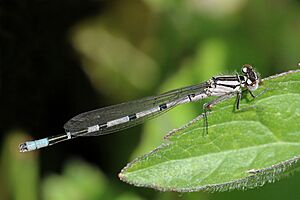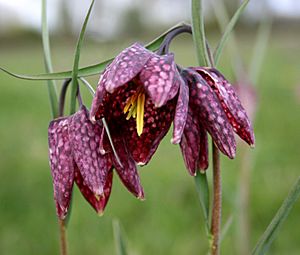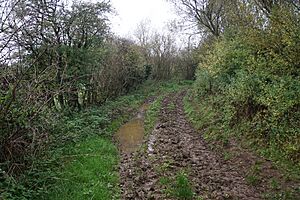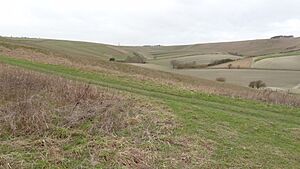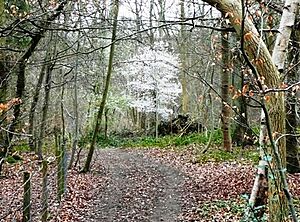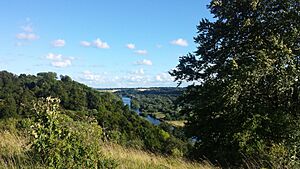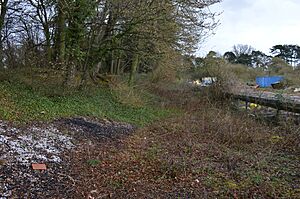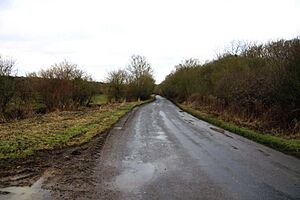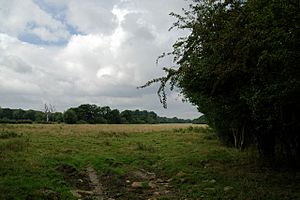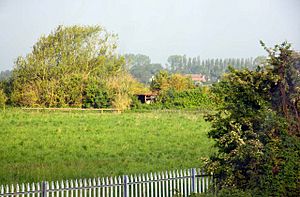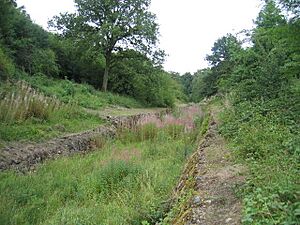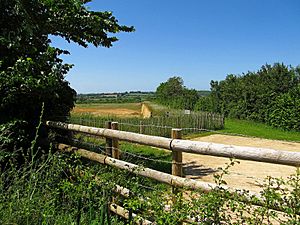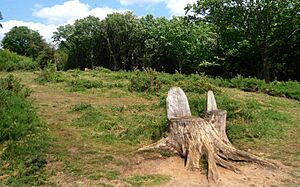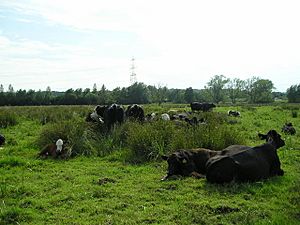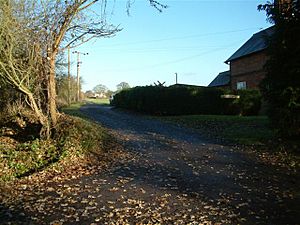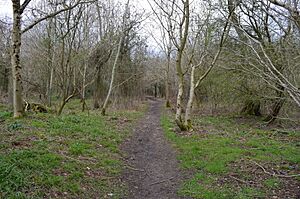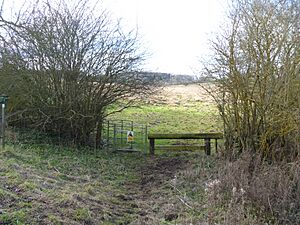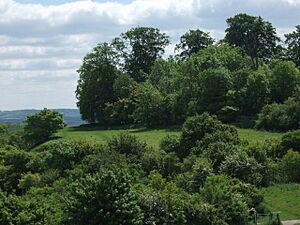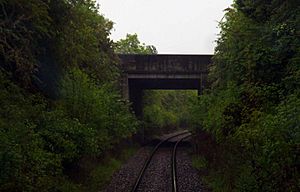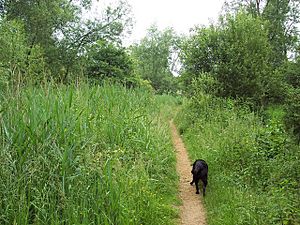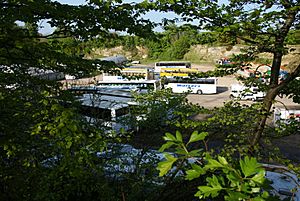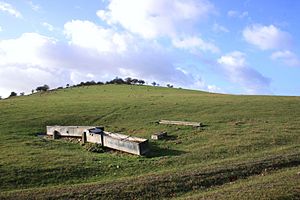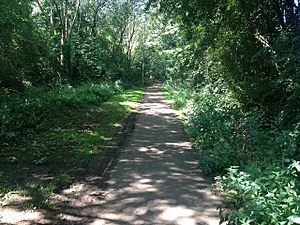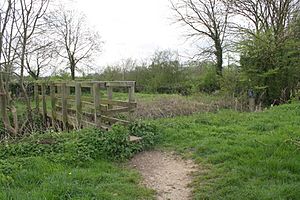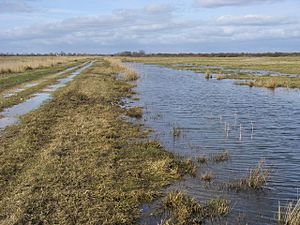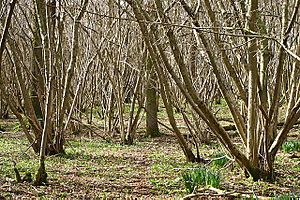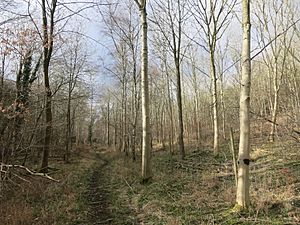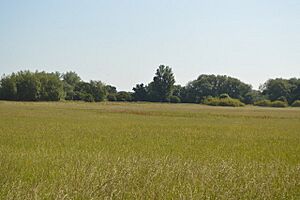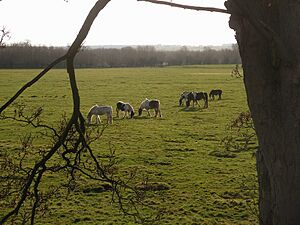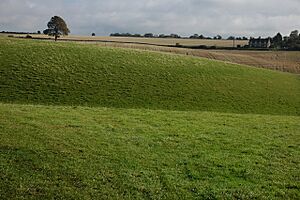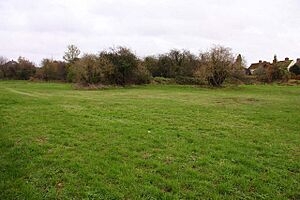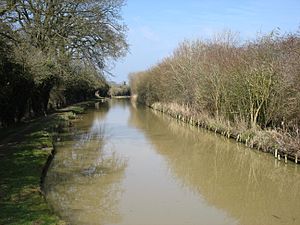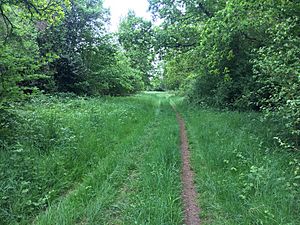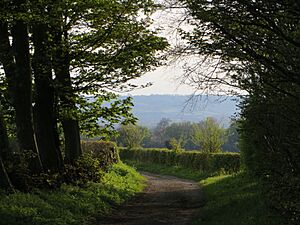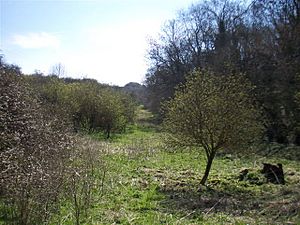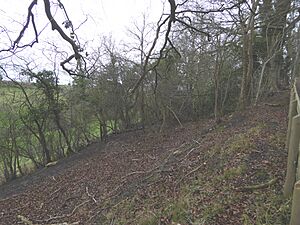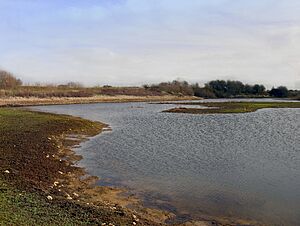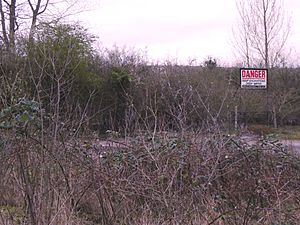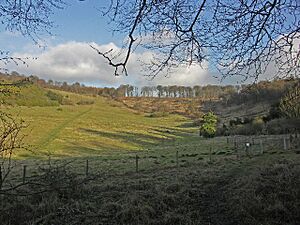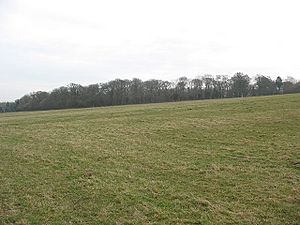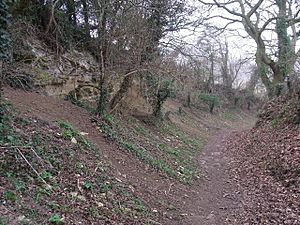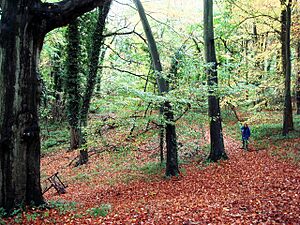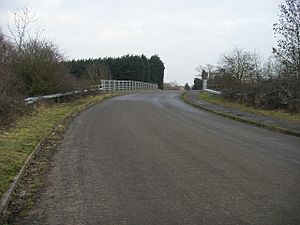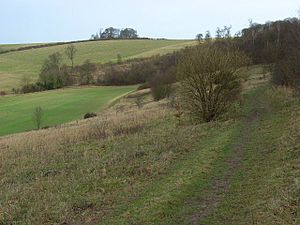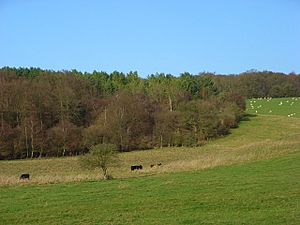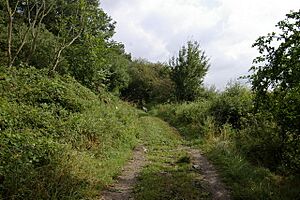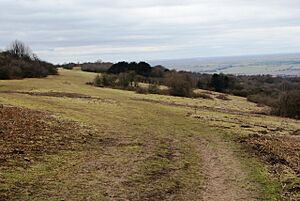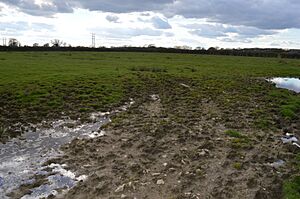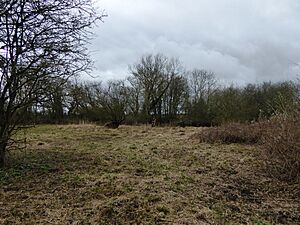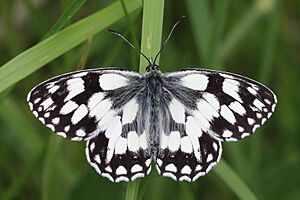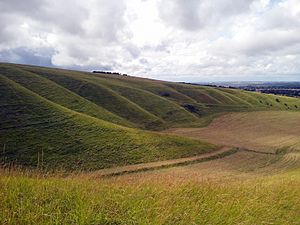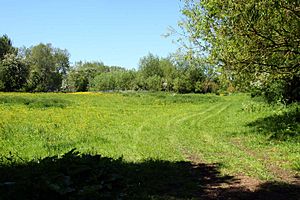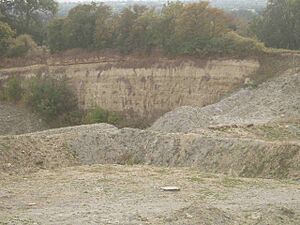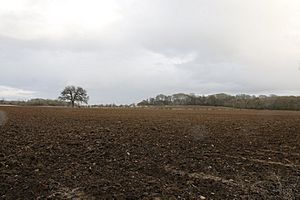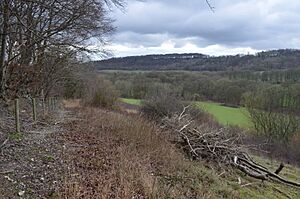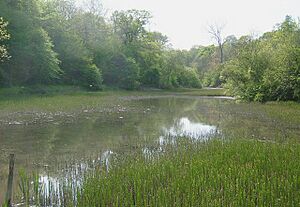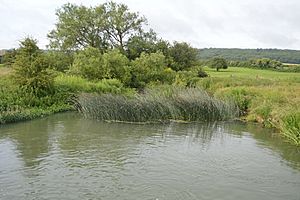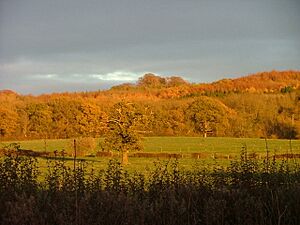List of Sites of Special Scientific Interest in Oxfordshire facts for kids
Oxfordshire is a county in South East England. It's a special place with lots of amazing natural areas. These areas are called Sites of Special Scientific Interest (SSSIs).
What are SSSIs? They are places that Natural England has chosen to protect. Natural England is a group that looks after England's natural environment. SSSIs are the very best spots for wildlife and geology (the study of rocks and Earth's history).
As of 2020, Oxfordshire has 111 SSSIs. Most of these (78) are important for their plants and animals. Some (27) are special for their rocks and landforms. A few (6) are important for both!
What do the symbols mean?
Why is it special?
Can you visit?
|
Other special names
|
Special Places in Oxfordshire
| Top - 0-9 A B C D E F G H I J K L M N O P Q R S T U V W X Y Z |
Alvescot Meadows
This meadow is a special place for nature.
- B
- Public access: No info
- Location: Alvescot
Appleton Lower Common
This common has many different kinds of trees and plants. You can find beautiful flowers like primrose and wood anemone here. It's also home to rare insects, like the club-tailed dragonfly.
- B
- Public access: FP
- Location: Appleton
Ardley Cutting and Quarry
This place is important for both nature and rocks! The quarry shows rocks from about 167 million years ago. This helps scientists understand the Jurassic Period in Britain. The site also has special grasslands and is home to the great crested newt, which is a protected animal.
- B, G
- Public access: PP
- Location: Ardley
- Other: BBOWT, GCR, SM
Ardley Trackways
This site is super important worldwide! It has fossilized footprints made by herds of huge plant-eating dinosaurs (sauropods). There are also tracks from meat-eating dinosaurs (theropods). These tracks are from about 165 million years ago. They are the only ones like this in England and help us learn how dinosaurs moved and behaved.
- G
- Public access: NO
- Location: Bucknell
- Other: GCR
Arncott Bridge Meadows
These are old hay meadows next to the River Ray. They haven't been ploughed for hundreds of years! This means they have many different plants, including some rare ones like the narrow-leaved water-dropwort.
- B
- Public access: NO
- Location: Arncott
Ashdown Park
Ashdown Park is special because of the lichens growing on its many large rocks. Lichens are like tiny plants that grow on surfaces. The park is grazed by animals to make sure these slow-growing lichens get enough sunlight.
- B
- Public access: YES
- Location: Ashbury
Aston Rowant
This site has beech woodlands, bushes, and chalk grasslands. You can find unusual plants like wood barley and different types of orchids here. It's also home to many kinds of beetles, moths, and fifty different bird species that breed here.
- B
- Public access: YES
- Location: Shirburn
- Other: NCR, NNR, SAC
Aston Rowant Cutting
This cutting shows rocks from about 88 million years ago. It's the best place in central England to see rocks from this time. It also has many fossils, which help scientists understand ancient times.
- G
- Public access: YES
- Location: Shirburn
- Other: GCR
Aston Rowant Woods
Natural England says this is a very important area of old woodland. It's a large, natural forest typical of the Chilterns hills. It has 52 types of plants that only grow in old woods, and over 100 kinds of fungi.
- B
- Public access: YES
- Location: Aston Rowant
- Other: NCR, NNR, SAC
Aston Upthorpe Downs
This site has dry valleys in the Berkshire Downs. Most of it is chalk grassland with many different plants and animals. You can find rare plants like wild candytuft and the pasque flower, which is very special to this area.
- B
- Public access: YES
- Location: Aston Upthorpe
- Other: NCR
Barrow Farm Fen
This fen is a special wetland area.
- B
- Public access: No info
- Location: Marcham
Bear, Oveys and Great Bottom Woods
This beech woodland has over 40 types of ground plants that are common in old woods in southern Britain. You can find plants like broad-leaved helleborine and woodruff here.
- B
- Public access: FP
- Location: Rotherfield Peppard
Berins Hill Bank
This bank is a special place for nature.
- B
- Public access: No info
- Location: Ipsden
Berrick Trench
This is an old, natural beech wood on a hillside. It has many old tree stumps that have regrown, like ash, oak, and hazel. You can see woodland flowers like early purple orchid here.
- B
- Public access: FP
- Location: Swyncombe
Bestmoor
This moor is a special place for nature.
- B
- Public access: No info
- Location: North Aston
Bix Bottom
This site has ancient woods that have been around since at least 1786! It also has grassy clearings and bushes. Over 500 types of plants have been found here, including 18 kinds of orchids and the rare meadow clary. There are also more than 75 bird species and 650 types of fungi.
- B
- Public access: YES
- Location: Swyncombe
- Other: BBOWT
Blenheim Park
This park used to be a hunting ground long ago. Now, it has some of the best grasslands and oak woodlands in the country. The big lakes were made in the 1700s and are important for birds that breed or spend winter here. It's also home to three rare beetles.
- B
- Public access: YES
- Location: Woodstock
Bould Wood
This site is mostly old, natural woodland. It also has two streams, a pond, and a wet meadow. It's home to many different lower plants, fungi, and lichens.
- B
- Public access: PP
- Location: Chipping Norton
- Other: BBOWT
Brasenose Wood and Shotover Hill
Brasenose Wood is a piece of the old Shotover Forest. It's managed in a traditional way, which helps many different plants grow. Over 220 types of plants have been found here, including 46 that are typical of ancient woodlands. Shotover Hill has heathland and grasslands. Natural England says it's "outstanding" for its insects, with many rare flies, bees, wasps, and ants.
- B
- Public access: YES
- Location: Headington
- Other: NCR
Buckland Warren
This small strip of land is special because it has a population of the very rare broad-leaved cudweed. This plant is found in less than ten places in Britain! It needs the soil to be disturbed by ploughing to grow.
- B
- Public access: NO
- Location: Buckland
Cassington Meadows
This meadow is a special place for nature.
- B
- Public access: No info
- Location: Witney
- Other: SAC
Chimney Meadows
This site has six rich meadows that are next to the River Thames. The meadows are cut by ditches and have common grasses like crested dog's-tail.
- B
- Public access: PP
- Location: Bampton
- Other: BBOWT, NNR
Chinnor Chalk Pit
Natural England says this site is important because it shows rocks from about 100 million years ago. It has many fossils of ammonites, which are ancient sea creatures.
- G
- Public access: NO
- Location: Chinnor
- Other: GCR
Chinnor Hill
This hill has grasslands rich in different plant species, juniper bushes, and woodlands. Over 300 types of plants and 65 bird species have been recorded here. Many small birds breed in the bushes, and thrushes eat berries in winter.
- B
- Public access: YES
- Location: Chinnor
- Other: BBOWT
Cothill Fen
This site is special for both its nature and geology. It has rare wetland habitats and many different insects, including 25 species that are on the Red Data Book of Invertebrates (meaning they are threatened). Over 330 types of plants have been found here. Geologically, it's important because studying the peat helps us understand plants from 10,000 to 6,500 years ago.
- B, G
- Public access: PP
- Location: Marcham
- Other: BBOWT, GCR, NCR, NNR, SAC
Culham Brake
This brake (a thicket or dense growth of bushes) is a special place for nature.
- B
- Public access: No info
- Location: Culham
Cumnor
This site is important for its geology.
- G
- Public access: No info
- Location: Oxford
- Other: GCR
Ditchley Road Quarry
This quarry is important for its geology.
- G
- Public access: No info
- Location: Charlbury
- Other: GCR
Dry Sandford Pit
This old sand quarry shows layers of limestone rocks that formed in shallow coastal waters about 160 million years ago. It has many fossil ammonites. It also has different habitats like fen, grassland, and heath. It's very important for insects, especially bees and wasps.
- B, G
- Public access: YES
- Location: Abingdon
- Other: BBOWT, GCR
Ducklington Mead
This meadow is managed in a traditional way and has many different plants. It's home to the rare snake's-head fritillary flower, which is becoming less common. It also has ditches with interesting wetland plants and an old hedge with various bushes.
- B
- Public access: NO
- Location: Ducklington
Fernham Meadows
This meadow is a special place for nature.
- B
- Public access: No info
- Location: Faringdon
Frilford Heath, Ponds and Fens
Natural England says the grasslands, heathland, and fens here are unique in southern England. Over 400 types of plants have been found, including some that are nationally rare. There are also unusual insects like a rare wasp and threatened flies.
- B
- Public access: PP
- Location: Abingdon
- Other: BBOWT
Glyme Valley
This site follows parts of the River Glyme valley. It has many different habitats, including the river, ponds, fens, grasslands, and woodlands. It's home to a large group of meadow clary, a rare plant. Badgers also live here.
- B
- Public access: PP
- Location: Chipping Norton
- Other: BBOWT
Grafton Lock Meadow
This meadow is a special place for nature.
- B
- Public access: No info
- Location: Faringdon
Hackpen, Warren & Gramp's Hill Downs
This site has three areas of natural chalk grassland, which are kept short by grazing animals. Eleven types of butterflies have been seen here, including the chalkhill blue and marbled white.
- B
- Public access: YES
- Location: Childrey
- Other: SM
Harpsden Wood
Most of this old wood is on acidic clay, but some parts are on chalky soil. The chalky areas have many different ground plants. You can find orchids like broad-leaved helleborine and bird's-nest orchid here.
- B
- Public access: YES
- Location: Henley-on-Thames
Hartslock
This site on the east bank of the River Thames has many different natural habitats. These include chalk downland, ancient yew woodland, and riverside fens. It was listed in 1915 as a place "worthy of preservation" by Charles Rothschild, who started the Wildlife Trusts. The wood has various trees and a large group of badgers.
- B
- Public access: YES
- Location: Goring-on-Thames
- Other: BBOWT, SAC
Highlands Farm Pit
This site shows gravel from an old channel of the River Thames. This channel existed before the Anglian ice age, about 450,000 years ago. It's very important for understanding the river's history. Many ancient flint tools have been found here, which are some of the earliest of their kind. Natural England calls it a "crucial site."
- G
- Public access: YES
- Location: Henley-on-Thames
- Other: GCR
Holly Court Bank
This bank is a special place for nature.
- B
- Public access: No info
- Location: Witney
Holly Wood
This old wood is a small part of the medieval Royal Forest of Shotover. It's managed in a traditional way and has many different insects. You can find uncommon butterflies like the black hairstreak and purple emperor here.
- B
- Public access: NO
- Location: Oxford
Holton Wood
This ancient wood was once part of Bernwood Forest, a medieval hunting forest. It's managed traditionally, with old oak trees. It has many different insects, including 27 types of butterflies, like the white admiral and purple emperor.
- B
- Public access: FP
- Location: Oxford
Hook Meadow and The Trap Grounds
These meadows are in the floodplain of the River Thames. They are often wet and have clay soils. The southern field is the wettest and has wetland plants like marsh arrow grass and early marsh orchid.
- B
- Public access: NO
- Location: Oxford
Hook Norton Cutting and Banks
This site is a nature reserve along an old railway line. Most of it is grassland with many different plants. It's known for its bee species, including one found in only three other places in the country. The cutting also shows rocks from about 167 million years ago.
- B, G
- Public access: PP
- Location: Chipping Norton
- Other: BBOWT, GCR
Horsehay Quarries
These quarries show rocks from the Middle Jurassic period. They help scientists understand the different layers of rock from about 172 to 167 million years ago.
- G
- Public access: NO
- Location: Chipping Norton
- Other: GCR
Hurst Hill
This hill is important for both its nature and geology. Its mosses and liverworts have been studied for over fifty years. Geologically, it's famous because a fossil of a large plant-eating dinosaur, Camptosaurus prestwichii, was found here in 1879. This dinosaur lived about 143 million years ago.
- B, G
- Public access: YES
- Location: Cumnor
- Other: GCR
Iffley Meadows
These meadows are between two parts of the River Thames. They are managed traditionally for hay and grazing. The soil is enriched by silt when the river floods each year. A special feature is the 89,000 snake's head fritillaries that bloom purple in spring.
- B
- Public access: YES
- Location: Oxford
- Other: BBOWT
Kirtlington Quarry
This old quarry is one of only five Middle Jurassic mammal sites in the world! It has the most different types of mammal fossils. It dates back about 150 million years ago. You can also find fossils of dinosaurs, crocodiles, and sharks here.
- G
- Public access: YES
- Location: Kidlington
- Other: GCR, LNR
Knightsbridge Lane
This site is a woodland along a small road. It's special because it has about one-tenth of all the very rare green hound's tongue plants in the country. This plant is found in only seven other places in Britain. It often grows where the soil has been disturbed.
- B
- Public access: YES
- Location: Watlington
Lamb and Flag Quarry
This quarry is important for its geology.
- G
- Public access: No info
- Location: Abingdon
- Other: GCR
Lambridge Wood
The soil in this wood changes from chalky to very acidic. The main trees are beech, with some oak, ash, and elm. The ground is mostly covered in brambles and bracken.
- B
- Public access: YES
- Location: Henley-on-Thames
Langley's Lane Meadow
This meadow is a special place for nature.
- B
- Public access: No info
- Location: Witney
Little Tew Meadows
This site has four natural meadows. One is used for hay, and the others are grazed by cattle. Two of them still show old medieval plough lines. There are also wet areas and limestone outcrops from an old quarry.
- B
- Public access: FP
- Location: Little Tew
Little Wittenham
This site is managed by the Earth Trust. It has woods, grasslands, bushes, and ponds on a hillside next to the River Thames. You can find the rare greater dodder plant here. It's also home to one of the largest groups of great crested newts in the country, which are a very important protected species.
- B
- Public access: YES
- Location: Dorchester-on-Thames
- Other: SAC
Littlemore Railway Cutting
This cutting shows limestone and clay rocks that were laid down about 160 million years ago. The clay seems to have been deposited in a channel between coral reefs that once covered the Oxford area.
- G
- Public access: NO
- Location: Oxford
- Other: GCR
Littleworth Brick Pit
This pit is important for its geology.
- G
- Public access: No info
- Location: Oxford
- Other: GCR
Long Hanborough Gravel Pit
This pit is important for its geology.
- G
- Public access: No info
- Location: Witney
- Other: GCR
Lye Valley
This is a special type of wetland called a calcareous valley fen, which is rare and threatened in the country. It has many different moss species. Rare insects like the soldier fly and uncommon spiders also live here.
- B
- Public access: YES
- Location: Oxford
- Other: LNR
Lyehill Quarry
This old quarry shows rocks from about 160 million years ago. These rocks are limestones from an unstable reef area. The only fossils found here are oysters.
- G
- Public access: NO
- Location: Oxford
- Other: GCR
Magdalen Grove
This grove is important for its geology.
- G
- Public access: No info
- Location: Oxford
- Other: GCR
Magdalen Quarry
This quarry is important for its geology.
- G
- Public access: No info
- Location: Oxford
- Other: GCR, LNR
Middle Barton Fen
This fen is a special wetland area.
- B
- Public access: No info
- Location: Chipping Norton
Moulsford Downs
This chalk grassland site has rich wildlife. It's home to many different insects, including the uncommon robber-fly and the adonis blue butterfly.
- B
- Public access: NO
- Location: Moulsford
Murcott Meadows
This meadow is a special place for nature.
- B
- Public access: No info
- Location: Oxford
- Other: BBOWT
Neithrop Fields Cutting
This site shows rock layers from about 190 to 180 million years ago. It helps us understand that this area was once next to an island called the "London landmass." It has many fossil ammonites. Natural England says it's a "key" site for understanding ancient geography and rock layers.
- G
- Public access: YES
- Location: Banbury
- Other: GCR
New Marston Meadows
These meadows are in the floodplain of the River Cherwell. They are managed traditionally for hay or by grazing. Some plants here are typical of old meadows, like common meadow-rue. The nationally scarce snake's head fritillary is also found here.
- B
- Public access: PP
- Location: Oxford
Otmoor
This site in the floodplain of the River Ray has damp grasslands, wet sedge, woodlands, and pools. Over sixty bird species breed here, like curlew and lapwing. In winter, birds like teal, wigeon, and snipe visit.
- B
- Public access: PP
- Location: Murcott
Out Wood
This natural wood is a piece of the medieval Royal Forest of Wychwood. It's managed traditionally, with oak trees of different ages. The paths have many different ground plants, including meadow saffron and greater butterfly orchid.
- B
- Public access: PP
- Location: Woodstock
Pishill Woods
These natural woods have many different ground plants, including 35 species found in ancient woodlands. The southern part has beech and oak trees that have been coppiced (cut back to regrow). The northern part has mostly mature beech trees.
- B
- Public access: PP
- Location: Henley-on-Thames
Pixey and Yarnton Meads
These are natural flood meadows next to the River Thames. They have been grazed and cut for hay for over a thousand years! This has made them very rich in plants, with over 150 species. Scientists have studied the plants and water here in detail.
- B
- Public access: PP
- Location: Oxford
- Other: NCR, SAC
Port Meadow with Wolvercote Common and Green
This site has meadows in the floodplain of the River Thames. It's believed to have been grazed for over a thousand years. It's a classic place to study how grazing affects plants. While it has fewer types of plants than nearby hay fields, 178 flowering plants have been recorded. This includes the creeping marshwort, a rare plant found nowhere else in Britain.
- B
- Public access: PP
- Location: Oxford
- Other: NCR, SAC, SM
Priest's Hill
This hill is important for its geology.
- G
- Public access: No info
- Location: Henley-on-Thames
- Other: GCR
Reed Hill
This sheltered valley has natural limestone grassland, secondary woodland, and bushes. A spring makes the ground damp in some areas. It's home to many insects, including the small blue and Duke of Burgundy butterflies.
- B
- Public access: NO
- Location: Witney
Rock Edge
This site shows limestone rocks rich in coral, formed when the area was under a warm, shallow sea, like the Bahamas today. It has many fossils from these coral reefs. These rocks are from about 145 million years ago.
- G
- Public access: YES
- Location: Oxford
- Other: GCR, LNR
Rushy Meadows
These natural grasslands are next to the Oxford Canal. They have many different plant species, like hard rush and water avens, which is very uncommon in the Thames Basin.
- B
- Public access: NO
- Location: Kidlington
Salt Way, Ditchley
This is an old track with rich grass verges and hedges. It's special because it has the largest known group of the very rare downy woundwort plant in Britain. This plant is found in only seven other places and often grows along old Roman roads and tracks.
- B
- Public access: YES
- Location: Chipping Norton
- Other: LNR
Sarsgrove Wood
This ancient wood has different types of rocks, which means different soil conditions. A stream runs through it, making some areas wet. Drier areas have ground plants like early-purple orchid, bluebell, and sweet violet.
- B
- Public access: NO
- Location: Chipping Norton
Sharp's Hill Quarry
This quarry is the "type locality" for the Sharp's Hill Formation, meaning it's the main place where these rocks were first studied. It has many fossils and dates back to about 167 million years ago. It's very important for understanding the rock layers in north Oxfordshire.
- G
- Public access: NO
- Location: Banbury
- Other: GCR
Sheep's Banks
This steeply sloping site has rich grassland that is managed traditionally. An old hedge runs along it, and a small stream flows nearby. You can find five types of orchids here, including bee and pyramidal orchids.
- B
- Public access: NO
- Location: Woodstock
Shellingford Crossroads Quarry
This site shows rocks from about 160 million years ago. It has many fossils of corals and shellfish that lived in reefs. It's also important for understanding the complex rock layers of this period.
- G
- Public access: YES
- Location: Faringdon
- Other: GCR
Shipton-on-Cherwell and Whitehill Farm Quarries
This site shows rock layers from about 167 million years ago. Natural England says Shipton-on-Cherwell Quarry is "internationally important" because it's one of the best sites for finding reptile fossils from this time. It has yielded fossils of two types of crocodiles and a dinosaur called Dacentrurus vetustus.
- G
- Public access: NO
- Location: Kidlington
- Other: GCR
Shirburn Hill
This hill has chalk grassland, chalk heath, bushes, and woodlands. Most grasslands in the Chilterns are grazed by animals, but this site is special because it's mainly grazed by rabbits. It has areas with taller grasses and large areas of hawthorn and buckthorn bushes.
- B
- Public access: YES
- Location: Watlington
Sidling's Copse and College Pond
This copse (small wood) and pond are special places for nature.
- B
- Public access: No info
- Location: Oxford
- Other: BBOWT
Spartum Fen
This fen is a special wetland area.
- B
- Public access: No info
- Location: Oxford
Stanton Great Wood
This wood is managed traditionally. The main trees are oak, ash, and hazel. It has many different plants and insects. Moths like the buff footman and the nationally uncommon small black arches live here.
- B
- Public access: NO
- Location: Oxford
Stanton Harcourt
This site is important for its geology.
- G
- Public access: No info
- Location: Witney
- Other: GCR
Stonesfield Common, Bottoms and Banks
This site has steep valleys and banks. Most of it is natural limestone grassland and bushes, but there's also an area of old, natural woodland. The common has upright brome grass and flowers like field scabious and pyramidal orchid.
- B
- Public access: PP
- Location: Witney
Stonesfield Slate Mines
This site is important for its geology.
- G
- Public access: No info
- Location: Witney
- Other: GCR
Stratton Audley Quarries
These quarries are important for their geology.
- G
- Public access: No info
- Location: Bicester
- Other: GCR
Sturt Copse
This wood has many huge old tree stumps that have regrown, like ash and elm, along with oaks. The ground is mostly covered by dog's mercury. You can find uncommon plants here like yellow star-of-Bethlehem.
- B
- Public access: FP
- Location: Witney
Sugworth
This site dates back over half a million years to a warm period between ice ages. It's an old river channel with rich deposits of fossils. You can find bones of vertebrates, tiny shellfish, molluscs, beetles, and plant remains here.
- G
- Public access: NO
- Location: Abingdon
- Other: GCR
Swyncombe Downs
This area has chalk grassland and bushes on the steep slopes of the Chiltern Hills. Natural England says it's outstanding for its butterflies and moths. Butterflies include the nationally rare silver-spotted skipper and dark green fritillary.
- B
- Public access: PP
- Location: Henley-on-Thames
- Other: SM
Taynton Quarries
These quarries are a special place for nature.
- B
- Public access: No info
- Location: Taynton
Tuckmill Meadows
This meadow is a special place for nature.
- B
- Public access: No info
- Location: Shrivenham
- Other: LNR
Warren Bank
This steeply sloping site has natural chalk grassland and bushes. It has many different plants, including horseshoe vetch and bee orchid. There are also many insects, with butterflies like the dark green fritillary.
- B
- Public access: YES
- Location: Wallingford
- Other: BBOWT
Waterperry Wood
This wood is special because it has many different and important insects, including many rare species. There are nineteen types of uncommon hoverflies, many uncommon beetles, thirty butterfly species, and several rare moths.
- B
- Public access: YES
- Location: Forest Hill
- Other: NCR
Watlington and Pyrton Hills
This site has chalk grassland with many different flowers, chalk bushes, and woodlands. Watlington Hill has short grass, grazed by rabbits. You can find flowering plants like yellow-wort and the nationally rare candytuft.
- B
- Public access: PP
- Location: Watlington
- Other: LNR
Wendlebury Meads and Mansmoor Closes
Wendlebury Meads has several meadows that have been managed traditionally. They have many different plants. Most show signs of old medieval ploughing. Mansmoor Closes were fenced off before 1622 and are important for their history and landscape. Over 160 plant species have been found here.
- B
- Public access: FP
- Location: Kidlington
- Other: BBOWT, NCR
Weston Fen
This site has many different habitats, including a fast-flowing stream, rich fen, willow woodland, and grassland. There are several rare types of beetles here.
- B
- Public access: FP
- Location: Bicester
Westwell Gorse
This gorse (bushy area) is a special place for nature.
- B
- Public access: No info
- Location: Burford
Whitecross Green and Oriel Woods
These ancient woods were once part of two old royal forests, Shotover and Bernwood. They have paths with many different plants and grasses, some with ditches. There's also a pond and a marsh. Twenty-four types of butterflies have been seen here, including the nationally rare black hairstreak.
- B
- Public access: YES
- Location: Murcott
- Other: BBOWT
Whitehill Wood
This wood is a special place for nature.
- B
- Public access: No info
- Location: Witney
Whitehorse Hill
This dry valley shows evidence of slow downhill movement of soil due to freezing and thawing during cold periods over half a million years ago. The site has natural chalk grassland with many different plants, especially in old chalk quarries.
- B, G
- Public access: PP
- Location: Faringdon
- Other: GCR, SM
Wicklesham and Coxwell Pits
These pits are important for their geology.
- G
- Public access: No info
- Location: Faringdon
- Other: GCR
Wolvercote Meadows
These meadows next to the River Thames are managed traditionally for grazing and hay. They have many different plants. The largest field is used for grazing, and others are for hay. There are also water channels with many dragonflies.
- B
- Public access: PP
- Location: Oxford
- Other: SAC
Woodeaton Quarry
This site shows rock layers from about 167 million years ago. It has one of the most complete sections of rocks from this period in the county. Natural England says it's "of great palaeontological and sedimentological interest," meaning it's important for studying ancient life and how rocks formed.
- G
- Public access: YES
- Location: Oxford
- Other: GCR
Woodeaton Wood
This wood is a piece of the ancient Shotover Forest. It's managed traditionally. The ground has plants like wood anemone, ramsons, and goldilocks buttercup.
- B
- Public access: NO
- Location: Oxford
Wormsley Chalk Banks
This site has chalk grassland rich in plants and insects that have become rare nationally. Flowers include bee and fly orchids, with the fly orchid becoming scarce. Insects include various butterflies, harvest spiders, and slowworms.
- B
- Public access: PP
- Location: Stokenchurch
Worsham Lane
This lane is a special place for nature.
- B
- Public access: No info
- Location: Witney
Wychwood
This is what's left of a large royal hunting forest. It's the biggest area of old broadleaved forest in the county. It also has limestone grassland and four marl lakes. Over 360 types of flowering plants and ferns have been found, along with 85 lichens and 60 mosses. It has many different insects, including 17 rare flies.
- B
- Public access: PP
- Location: Witney
- Other: NCR, NNR, SM
Wytham Ditches and Flushes
These ditches have many different water plants and fen plants. Uncommon wetland plants include greater water-parsnip and water violet. There's also a small field that stays partly wet from natural springs.
- B
- Public access: NO
- Location: Wytham
Wytham Woods
This site used to belong to Abingdon Abbey. It has ancient woodland and limestone grassland. Over 500 types of plants have been found here. This site has been studied a lot by Oxford University, so we have tons of information about its birds, mammals, and insects. Over 900 types of beetles, 580 types of flies, and 700 types of bees, wasps, and ants have been recorded!
- B
- Public access: YES
- Location: Wytham
- Other: NCR
More to explore
- Berkshire, Buckinghamshire and Oxfordshire Wildlife Trust
- List of local nature reserves in Oxfordshire


